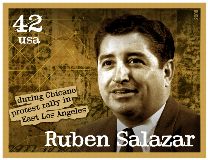
Generate national and local Hispanic media attention for the American Journalists stamps, including the Ruben Salazar stamp.
Ruben Salazar was born on March 3, 1928, in Ciudad Juárez, Mexico, and raised in El Paso, Texas. He was the first Mexican-American journalist to have a major voice in American mainstream news media. Having written for the El Paso Herald-Post and the Los Angeles Times, in 1965 Salazar became a foreign correspondent, reporting from the Dominican Republic and South Vietnam prior to becoming chief of the Los Angeles Times Mexico City bureau. In 1970, Salazar became the news director of KMEX, a Spanish-language television station, and served in that capacity until later that same year when he was killed while covering the National Chicano Moratorium against the Vietnam War. Salazar’s work presents a valuable view of the evolution of Mexican-American politics into the larger Chicano movement.
A number of our strongest Spanish-language spokespersons, including Hispanic programs specialists, will work with Public Affairs representatives to garner Hispanic media coverage for the American Journalists stamps, including the Ruben Salazar stamp, and build relationships with Hispanic news media representatives, including members of the National Association of Hispanic Journalists.
1. Postage stamps do much more than just make it possible for your mail to be delivered. For more than 150 years, the Postal Service, through its stamp program, has celebrated the people, events, and cultural milestones that form our unique American experience.
2. Postage stamps help tell the story of our shared heritage, one that is immensely rich because of its diversity. The Postal Service’s commemorative stamp program honors Americans who have made notable contributions to American heritage.
3. Since 1869, the Postal Service’s commemorative stamp program has been honoring Hispanic people, places, and events, beginning in 1869 with a Spanish Explorers stamp set, which included Rodrigo de Escobar. Contemporary stamps included baseball great, Roberto Clemente; labor leader, Cesar E. Chavez; artist, Frida Kahlo; the Panama Canal; San Juan, Puerto Rico; Southwest Settlement; Cinco de Mayo; and the popular Latin Dance stamps.
4. The American Journalists stamp series honors five journalists, including Ruben Salazar, who reported some of the most important stories of the 20th century.
5. The Postal Service recognizes and honors diversity in its workforce, and employs approximately 56 thousand Hispanics, from mail handlers to vice presidents, who take pride in helping to deliver record-breaking service to the American people.
6. The Postal Service’s commitment to a diverse workforce was reflected in its being named one of the best companies for Hispanics, an honor from Hispanic Business magazine.
7. Another reflection of the Postal Service’s commitment to diversity is its Employee Development and Diversity department, which oversees programs such as National Diversity Initiatives, Leadership Development and Talent Management, Employee Development, and Equal Employment Opportunity.
8. Voted the “Most Trusted Governmental Agency” by the American people for 3 consecutive years (Ponemon Institute), the Postal Service fosters a business culture that provides an inclusive work environment for all employees.
9. Distinguished author and professor, Dr. Clara Rodriguez, a member of the Postal Service’s Citizen’s Stamp Advisory Committee, will assist the Postal Service with its longstanding tradition of honoring great Americans, places, and events on postage stamps.
